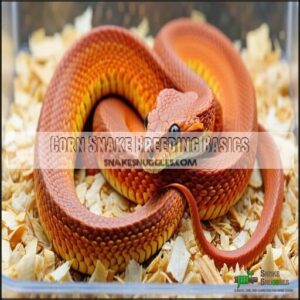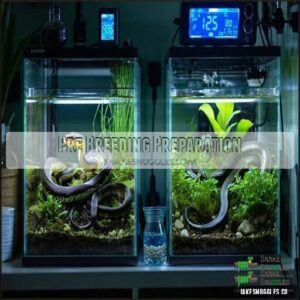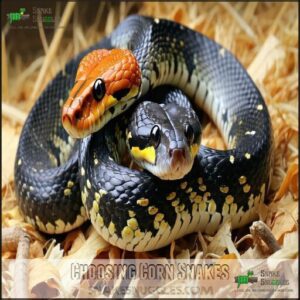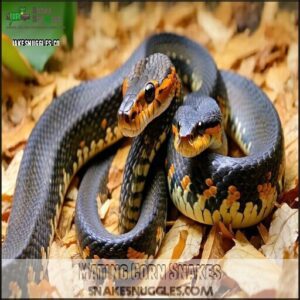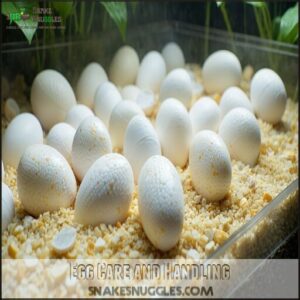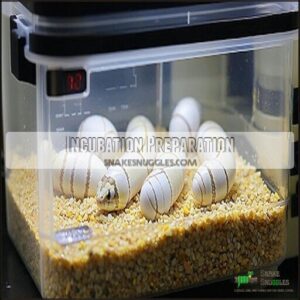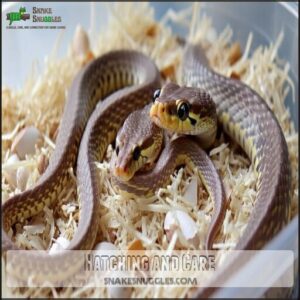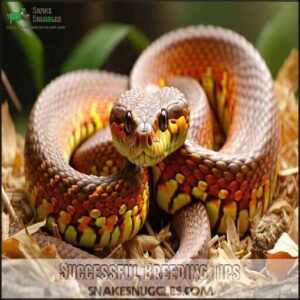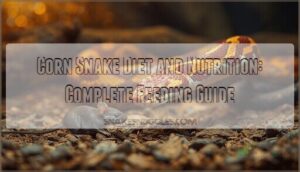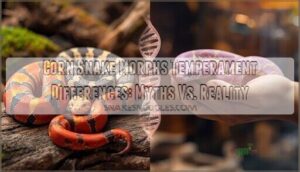This site is supported by our readers. We may earn a commission, at no cost to you, if you purchase through links.
 Corn snake breeding behavior is a mix of timing, temperature, and instinct.
Corn snake breeding behavior is a mix of timing, temperature, and instinct.
These snakes are seasonal breeders, with activity kicking off in spring after a cooling period called brumation.
Males court females by aligning their bodies, vibrating their tails, and using pheromones to signal interest—think of it as their version of a love letter.
Females respond when they’re ready to mate, and successful breeding often depends on proper environmental conditions like warmth, humidity, and healthy snakes.
It’s a delicate dance, but with the right prep, you can guide them through it.
Curious about egg care and hatching? There’s more to explore!
Table Of Contents
- Key Takeaways
- Corn Snake Breeding Basics
- Pre Breeding Preparation
- Choosing Corn Snakes
- Mating Corn Snakes
- Egg Laying Process
- Incubation Requirements
- Hatching and Care
- Breeding Cycle Timeline
- Breeding Challenges
- Successful Breeding Tips
- Frequently Asked Questions (FAQs)
- Should you breed corn snakes?
- How to know when corn snakes are ready to breed?
- What is corn snake behavior?
- How long does it take for corn snakes to mate?
- How does selective breeding affect wild corn snakes?
- How do you know if a corn snake is mating?
- Why do some corn snakes reject mates?
- How often can females produce eggs?
- Can corn snakes hybridize with other species?
- Do captive breeding patterns match wild behavior?
- Conclusion
Key Takeaways
- You’ll need to simulate seasonal changes with proper temperature cycling and humidity to trigger corn snake breeding behavior.
- Brumation is essential for preparing snakes for reproduction, requiring 12-16 weeks of gradual cooling.
- Healthy snakes, free from parasites and stress, are crucial for successful mating and egg production.
- Monitor environmental factors like temperature, humidity, and lighting to ensure smooth courtship, egg laying, and hatching.
Corn Snake Breeding Basics
You’ll need to create the right environment with proper temperature cycling and humidity levels before your corn snakes will successfully breed.
Create a cozy, cyclical climate – it’s the ultimate corn snake matchmaking service.
Corn snakes require a cooling period of 12-16 weeks, followed by a gradual warming phase that triggers their natural reproductive behaviors, which is a critical aspect of their natural reproductive behaviors.
Environmental Factors
In the sphere of corn snake breeding, environmental conditions play a vital role in triggering reproductive behaviors.
You’ll need to create proper temperature gradients and adjust lighting schedules to simulate seasonal changes. Humidity levels and habitat enrichment substantially impact breeding success.
Many breeders use rainfall cues to encourage mating, as these environmental signals naturally stimulate breeding season readiness after brumation.
Creating these natural conditions isn’t just helpful—it’s essential for successful reproduction.
Mimicking winter through gradual temperature reduction is key for breeding, and using rainfall cues can be particularly effective in stimulating the snakes. Environmental conditions and temperature gradients are crucial for simulating the natural cycles that trigger reproductive behaviors in corn snakes.
Temperature Control
While environmental conditions set the stage, temperature control is the director of your corn snake breeding show.
You’ll need to manipulate temperatures strategically throughout the breeding cycle. During brumation, gradually cool snakes to 10-15°C (50-59°F), then slowly warm them back to 28-29°C (82-84°F) to trigger mating behaviors.
A reptile thermostat is essential for maintaining consistent temperatures.
This seasonal simulation mimics natural cycles, with proper cooling methods ensuring successful breeding and healthy offspring development.
Humidity Levels
While temperature sets the stage, humidity plays the starring role in corn snake breeding success.
Maintain 50-60% humidity in enclosures during pre-breeding, but bump it to 70-80% when eggs arrive.
Too dry? Your snakes won’t shed properly. Too damp? You’re inviting respiratory infections.
Use a digital hygrometer for accurate humidity monitoring and adjust substrate moisture as needed—your corn snakes will thank you with healthy hatchlings! Many keepers purchase a reliable humidity reader to guarantee proper levels.
Pre Breeding Preparation
You’ll need to prepare your corn snakes properly before attempting to breed them, including a cooling period and careful health monitoring.
You can dramatically increase your breeding success rate by following the right pre-breeding steps, just like setting the stage before the main performance begins.
Brumation Process
Now that you understand the basics, let’s look at brumation—nature’s way of prepping corn snakes for romance.
Brumation mimics winter hibernation, triggering reproductive hormones that sync breeding cycles. You’ll start this process in early September with a gradual cooling period.
- Set up dedicated brumation tubs with proper ventilation
- Lower temps to 62-64°F (17-18°C) for 2-3 months
- Check daily for health issues, especially respiratory problems
- Maintain water dishes—hydration remains essential during winter cooling
Feeding Schedule
While preparing corn snakes for breeding, a proper feeding schedule is vital for reproductive success.
You’ll need to adjust meals based on the breeding cycle phase to guarantee superior health and fertility.
| Phase | Frequency | Food Size |
|---|---|---|
| Pre-Brumation | 1x weekly | Larger prey |
| Post-Brumation | 2-3x weekly | Medium prey |
| Breeding Season | Females: 2x weekly | Protein-rich items |
The provided table outlines the specific requirements for each phase, including frequency and food size, to ensure the snakes are well-prepared for the breeding season.
Health Checks
With your feeding schedule established, thorough health checks become your next priority.
With your feeding schedule established, thorough health checks become your next priority.
Think of health checks as your breeding insurance policy—small effort now, big payoff later.
Examine your corn snake breeding pairs for any signs of illness, looking for parasite prevention needs, shedding issues, respiratory infections, and scale rot.
Obesity risks can impact fertility, so maintain proper weight—it’s like making sure your car’s tuned up before a road trip, because healthy snakes breed better!
Choosing Corn Snakes
You’ll need to select sexually mature corn snakes that are at least 18 months old and measure a minimum of 30 inches in length for successful breeding.
When pairing your snakes, choose unrelated individuals to maintain genetic diversity and avoid the health complications that can arise from inbreeding.
Age and Maturity
Verifying the age and maturity of corn snakes is vital before breeding.
Your snake must reach sexual maturity at 16-18 months old and measure at least 30 inches (75cm) long.
First breeding attempts should wait until snakes are fully grown to avoid lifespan impact.
Don’t rush corn snake reproduction—patience guarantees healthier offspring and safer breeding behavior for both male and female snakes, ensuring a successful and healthier outcome.
Genetic Diversity
Diving into the sphere of corn snake genetics reveals a rainbow of possibilities beyond their single wild phenotype.
Selective breeding has opened up countless morph variations through dominant and recessive genes.
Consider these breeding impacts:
- The thrill of producing your first snow morph from amelanistic genes
- The pride of maintaining pure bloodlines through detailed lineage tracking
- The excitement of discovering a new mutation in your breeding project
- The satisfaction of watching selective breeding enhance colors over generations
- The wonder of seeing dominant characteristics express themselves in offspring, which can lead to a new mutation and enhance the overall breeding project with selective breeding.
Inbreeding Risks
While genetic diversity strengthens your breeding program, inbreeding poses significant risks.
When closely related corn snakes mate, recessive genes often pair up, increasing the chances of congenital defects like kinking, wobbling, or heart problems.
Mutation accumulation can lead to weaker offspring with reduced fertility and compromised immune systems.
Think of genetics like a recipe—too many ingredients from the same source, and you’re bound to make genetic mistakes that can harm future generations, affecting the overall genetic diversity and potentially causing congenital defects.
Mating Corn Snakes
You’ll notice your male corn snake rubbing his body against the female, a natural courtship behavior that often leads to successful mating.
When you’ve placed both snakes in the breeding enclosure at the right temperature and humidity, you’ll need to monitor their interactions closely for signs of mating readiness.
Courtship Behavior
Now that you’ve selected healthy, mature corn snakes, you’ll need to recognize their unique courtship rituals. Male corn snakes rely heavily on pheromone signals to locate receptive females during breeding season.
Watch for these key courtship behaviors:
- Chin rubbing and body twitching to entice the female
- Gentle tactile cues where males rub against females
- Dominance battles between rival males competing for mating rights
These intricate snake mating behaviors guarantee successful body alignment for hemipenes insertion.
Male and Female Interaction
After witnessing courtship rituals, you’ll notice specific interactions between corn snake pairs.
Male and female dynamics follow distinctive patterns during breeding season.
| Behavior | Male Response | Female Response | Duration |
|---|---|---|---|
| Pheromone Communication | Trail following | Scent release | 1-2 days |
| Dominance Battles | Fighting other males | Observing | Hours |
| Courtship Rituals | Body twitching | Receptivity signals | 30-60 min |
| Mating Alignment | Tail wrapping | Cloacal positioning | 2-4 hours |
The table outlines the specific behaviors, responses, and durations of interactions between male and female corn snakes, including pheromone communication and dominance battles.
Mating Success Factors
Success in corn snake mating depends on several key factors.
You’ll need to introduce snakes during the right season, when pheromone influence is strongest.
Monitor their behavior closely, but allow natural courtship to develop without interference.
Provide a stress-free environment by minimizing environmental stressors.
Remember that proper body alignment is essential for successful copulation.
Dominance battles between males are natural, so pair compatible mating pairs for best results.
Egg Laying Process
You’ll notice your female corn snake becoming restless and searching for a secluded spot about 5-6 weeks after successful mating, signaling she’s ready to lay her clutch of 10-30 eggs.
Once she begins the egg-laying process, it’s vital you provide a proper nesting box with damp sphagnum moss to maintain the 70-80% humidity needed for healthy egg development.
Nesting Behavior
A female corn snake’s nesting behavior begins with her prelay shed, signaling egg deposition is imminent. You’ll notice her searching for the perfect nest site, usually 10-14 days before laying her clutch.
Unlike corn snakes, boa constrictors exhibit ovoviviparity reproduction.
- Provide a secure nesting box with damp sphagnum moss to satisfy her natural instincts
- Watch for restless behavior and frequent probing of substrate
- Expect clutch sizes between 10-30 eggs, depending on the snake’s age and size, which is an important factor in her nesting behavior.
Egg Care and Handling
After corn snake egg laying, handle eggs gently to avoid damage. Use an incubation medium like vermiculite or perlite for support. Maintain stable humidity control to prevent dehydration.
Egg candling helps check fertility—just don’t shake them! Relocate eggs carefully, keeping their original orientation.
Healthy snake eggs lead to successful hatchling emergence, so monitor them regularly for signs of mold or distress.
| Task | Tip | Why It Matters |
|---|---|---|
| Egg Relocation | Keep eggs upright | Prevents embryo disorientation |
| Incubation Mediums | Use vermiculite or perlite | Supports proper moisture retention |
| Humidity Control | Maintain 70-90% humidity | Prevents egg dehydration |
| Egg Candling | Check for blood vessels | Confirms egg fertility |
| Hatchling Emergence | Monitor for mold or changes | Guarantees healthy development |
Incubation Preparation
Once the eggs are safely removed, proper incubation guarantees healthy hatchlings. Choose reliable incubation mediums like vermiculite or perlite for moisture retention.
Maintain humidity control at 70-90% and temperature stability between 78-80°F using a reptile incubator. For ideal results, consider investing in a temperature controlled device.
Keep egg orientation unchanged to avoid embryo harm. Use a clean container with a lid.
- Monitor for mold prevention weekly.
- Avoid overcrowding eggs.
- Adjust humidity with water sprays.
- Guarantee the incubator stays consistent and provides the necessary conditions for healthy development, ensuring healthy hatchlings through proper care.
Incubation Requirements
In the context of corn snake egg incubation, getting the setup right is key. Start with a reptile incubator set to a steady temperature range of 78-80°F and humidity control between 75-80%.
Too dry, and the eggs might shrivel; too wet, and you risk mold. Use incubation mediums like vermiculite or perlite to stabilize moisture.
Avoid egg rotation—keeping their original orientation prevents damage to the developing embryos. Check the eggs regularly for hatching issues, such as mold or slugs, and remove any that show signs of trouble.
A small thermometer and hygrometer are lifesavers for monitoring conditions. Think of the incubator as a mini spa for your snake eggs—warm, humid, and perfectly cozy for a successful hatch.
Hatching and Care
When your corn snake eggs finally hatch, you’ll need to be ready to provide the right care for those tiny, squirmy hatchlings.
From feeding pinky mice to maintaining proper humidity, it’s all about creating a safe and nurturing environment.
Hatchling Feeding
After the first shed, corn snake hatchlings are ready to eat.
Start with pinky-size prey items, offering them twice a week. You can use live or frozen-thawed mice, but frozen is safer and easier to store.
Hatchlings don’t need supplementation if prey is whole and fresh. Keep feeding consistent to support growth—these little snakes are quick learners at mealtime, and it is crucial for their growth!
Water and Hydration
After feeding, hatchlings need steady hydration to stay healthy.
Keep a shallow water dish handy—they’re tiny, so drowning’s a risk! Fresh water matters; poor quality can harm them.
Watch for dehydration signs like wrinkled skin or lethargy. One should also consider the humidity requirements for proper shedding.
Here’s a quick checklist:
- Use clean, chlorine-free water.
- Replace daily.
- Make easy access.
- Monitor drinking frequency.
- Balance shedding hydration needs.
Heat and Humidity
After confirming proper hydration, focus on heat and humidity for healthy hatchlings.
Maintain incubation temperatures between 78-80°F with humidity at 75-80%.
Use temperature gradients to mimic natural thermal conditions.
Humidity monitoring is key—fluctuations can impact development.
Seasonal variation in the corn snake breeding season highlights the importance of careful humidity management.
Balanced temperature control guarantees thriving hatchlings post-breeding.
Breeding Cycle Timeline
You’ll need to understand the corn snake’s breeding cycle to time everything just right.
From mating in spring to hatching in summer, each stage follows a predictable and fascinating timeline.
Gestation Period
During the gestation period, female corn snakes prepare for egg laying by developing eggs internally. They secrete nutrients and form protective shells around the embryos. Typically, this phase lasts 5-6 weeks after mating.
- Clutch size varies from 2 to 34 eggs.
- Females choose warm, humid nesting locations.
- Proper nutrition guarantees healthy embryo development and successful egg incubation.
Egg Laying to Hatching
A female’s egg laying marks a critical stage.
Eggs, about the size of small cigars, need careful placement in incubation mediums like vermiculite.
Maintain humidity control at 70-90% to prevent drying.
The incubation period lasts roughly two months at 78-80°F.
Watch for incubation failures, like moldy eggs.
Hatchling care begins post-hatch, focusing on warmth and hydration.
Breeding Season
After eggs hatch, the snake breeding season starts anew.
Seasonal triggers like warmer days and longer light cycles kick off the corn snake breeding cycle.
Regional variations affect timing, with year-round breeding possible in warmer climates.
First breeding happens when snakes reach 16-18 months.
Breeding frequency depends on health, but proper preparation guarantees smooth corn snake courtship and successful mating.
Success also hinges on temperature and humidity control.
Breeding Challenges
You’ll face several obstacles when breeding corn snakes, from stubborn snakes that refuse to mate to genetic complications that affect offspring health.
Despite careful preparation, you’ll need patience and problem-solving skills to address issues like egg binding, infertility, and stress-related feeding refusals that can derail your breeding project, requiring problem-solving skills.
Common Issues
Roadblocks can derail even the most planned corn snake breeding attempts.
You’ll encounter several common issues during your breeding journey:
- Egg binding due to calcium deficiency or environmental stress
- Infertility caused by improper brumation or nutrition
- Breeding risks from hybridization when unexpected morphs appear
- Snake breeding complications from parasites that weaken reproductive health
Stress reduction is essential—minimize handling and maintain consistent temperatures to avoid bacterial infections, which can lead to bacterial infections and require stress reduction to prevent reproductive health issues.
Health Risks
Beyond common breeding issues, health risks pose serious concerns for your corn snakes.
Breeding stress can weaken immune systems, making snakes vulnerable to bacterial and viral infections. Watch for egg binding in females – a potentially fatal condition where eggs can’t be passed.
Prolapse risks increase during difficult layings. Parasites may transmit between mating pairs, so quarantine new snakes.
Maintain pristine enclosures and handle with clean hands to minimize these snake breeding risks.
Genetic Disorders
While monitoring health risks during breeding, understanding genetic disorders becomes equally important.
Breeding genetics substantially impact your corn snake offspring’s wellbeing.
- Inbreeding increases deformities by expressing recessive genes
- Albinism and anerythrism are common autosomal recessive mutations
- The stargazer gene from sunkissed morphs causes neurological issues
- Linebreeding can result in mental and physical retardation
- Don’t breed snakes with obvious defects to maintain genetic health
Successful Breeding Tips
You’ll find breeding corn snakes successful when you combine proper timing with careful environmental control, much like a chef perfecting a recipe through both science and intuition.
Your patience during the breeding process pays off with healthy hatchlings, as rushing any stage from brumation to egg incubation can compromise your results.
Experience and Patience
Breeding corn snakes requires a three-part mindset: patience, observation, and commitment.
You’ll face a learning curve with your first clutch, but don’t get frustrated when things don’t go perfectly.
Watch closely for subtle mating behaviors and health changes. Many breeders fail because they rush the process – successful breeding often takes years of experience and careful attention to detail, which demands commitment.
Research and Planning
While patience develops through experience, proper research and planning are your foundation for successful breeding corn snakes.
Before pairing any reptiles, do your homework:
- Study genetic research on morph compatibility to prevent health issues
- Verify legal considerations for keeping and breeding in your area
- Calculate space requirements for both breeding and offspring
- Create a breeding checklist including ethical sourcing documentation
Your preparation directly impacts your success rate and the welfare of your snakes.
Snake Health and Wellness
Good planning sets the foundation, but your snake’s health ultimately determines breeding success.
Keep your corn snakes parasite-free through regular vet checks. Watch for shedding problems that might indicate nutritional deficiencies.
Prevent respiratory infections by maintaining proper humidity. Avoid obesity risks by following appropriate feeding schedules.
Remember, genetic health plays a huge role—like humans, snakes pass their strengths and weaknesses to offspring. Consistent snake health monitoring guarantees your breeding program thrives, and it is crucial for breeding success with proper humidity.
Frequently Asked Questions (FAQs)
Should you breed corn snakes?
You should consider breeding corn snakes only if you’re prepared for the responsibility. It’s time-intensive, requires specific knowledge of their cycles, and you’ll need homes for potential offspring.
How to know when corn snakes are ready to breed?
While breeding isn’t for beginners, you’ll know your corn snakes are ready when they’ve reached sexual maturity (16-18 months).
Completed brumation.
And males start shedding while females show signs of ovulation.
What is corn snake behavior?
You’ll notice your corn snake’s behavior includes active hunting, climbing, exploring at dawn and dusk.
Shedding cycles, defensive posturing when threatened.
And unique mating rituals that involve tactile communication between pairs.
How long does it take for corn snakes to mate?
Like a slow dance under moonlight, corn snake mating typically lasts 1-4 hours.
You’ll notice males pursuing females, aligning their bodies, and wrapping tails for successful sperm transfer during this intimate process.
How does selective breeding affect wild corn snakes?
Selective breeding doesn’t directly affect wild populations, but creates captive snakes with unnatural colors and patterns.
You’ll find these morphs often face health problems from inbreeding that wild corn snakes don’t experience.
How do you know if a corn snake is mating?
You’ll know your corn snakes are mating when the male follows the female closely, wraps his tail around hers, and they remain connected for hours.
Twitching movements and chin rubbing are telltale signs.
Why do some corn snakes reject mates?
Corn snakes can dramatically reject potential mates due to stress, poor health, incorrect timing in breeding cycle, or simply incompatible chemistry.
You’ll notice defensive posturing, hissing, or complete avoidance when they’re not interested.
How often can females produce eggs?
Healthy female corn snakes can produce eggs once annually, typically during spring or early summer.
Your snake will need proper nutrition and a temperature cycle that mimics seasonal changes for successful reproduction.
Can corn snakes hybridize with other species?
Yes, corn snakes can hybridize with other closely related species in the Pantherophis genus. You’ll find that rat snakes commonly crossbreed with corn snakes, producing viable offspring with mixed characteristics.
Do captive breeding patterns match wild behavior?
Captive breeding patterns often mimic wild behavior, especially with temperature cycling and brumation.
However, you’ve got more control in captivity, letting you tweak conditions like lighting and feeding to optimize breeding success year-round.
Conclusion
Picture the gentle rhythm of a corn snake’s courtship, a blend of instinct and preparation.
By understanding corn snake breeding behavior explained here, you’ll set the stage for successful mating. Focus on proper brumation, ideal temperatures, and healthy snakes to guarantee a smooth process.
Stay patient, monitor their interactions, and maintain prime conditions for egg care and hatching.
With research and care, you’ll guide your snakes through this fascinating cycle and enjoy the rewards of your effort.

